It’s common to have more than one bonsai Ficus bonsai tree variety in a personal collection.
Ficus are great beginner bonsai that often outlive their owners. It is often referred to as the “banyan tree bonsai” or “bonsai fig.” They have fast growth rates, are hardy, and can beautiful bonsai specimens.
This article details how to care for Ficus bonsai. We even showcase specific varieties to help you decide what suits your requirements best!
Caring For The Ficus Bonsai
The Ficus belongs to the mulberry family. It is the most popular plant for beginners in the bonsai hobby. There are between 800 – 2000 different Ficus species that exist.
Traditional Ficus Bonsai
Environment
The Ficus are tropical plants and can be kept inside year-round with ease. The Ficus can be kept outside if the temperature is above 60 degrees Fahrenheit. Many locations throughout the United States would allow keeping Ficus outside during the summer.
They prefer high humidity but can handle times of lower humidity due to their waxy leaves.



Indoor Ficus?
The temperature should be kept somewhat constant if possible. Usually, this can be achieved easily indoors (another reason this is a great candidate for indoor bonsai). A warm, bright location is most important. For growers who must keep their bonsai Ficus trees indoors, aerial root development is unlikely. However, some greenhouses do provide enough humidity. A summer outdoors will help maintain good health.

Collection of Ficus Bonsai (Demonstrating Different Styles)
Watering
Whenever the soil gets dry, water the Ficus. It tolerates occasional dry spells and days of over-watering, but like most plants, it doesn’t like it.
It’s encouraged to mist-spray the foliage of the Ficus daily if possible. The reason being, that the Ficus is tropical and is accustomed to constant moisture on its leaves, branches, and trunk.
During the winter, do not water as much. If it is kept in a sunny location that is warm during the winter, then the Ficus plant will require more watering when compared to a cooler spot.
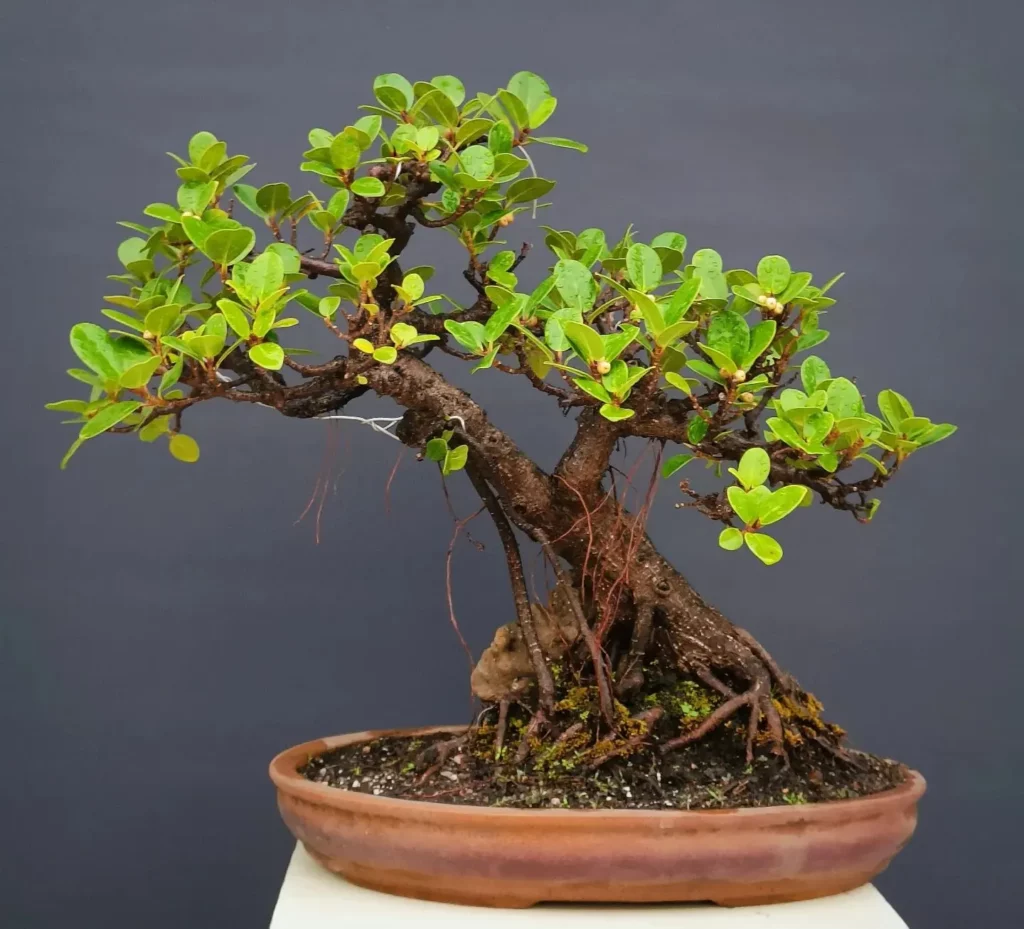


Fertilizing
Weekly fertilizing is recommended during the growing season. This can be with fertilizer pellets, tabs, or liquid fertilizer. The Ficus isn’t particularly picky about fertilizer type, so just make sure to do it.
Pruning
It is important to regularly prune your Ficus to maintain its shape from an early age. Leaf pruning is a great way to achieve smaller-sized leaves.
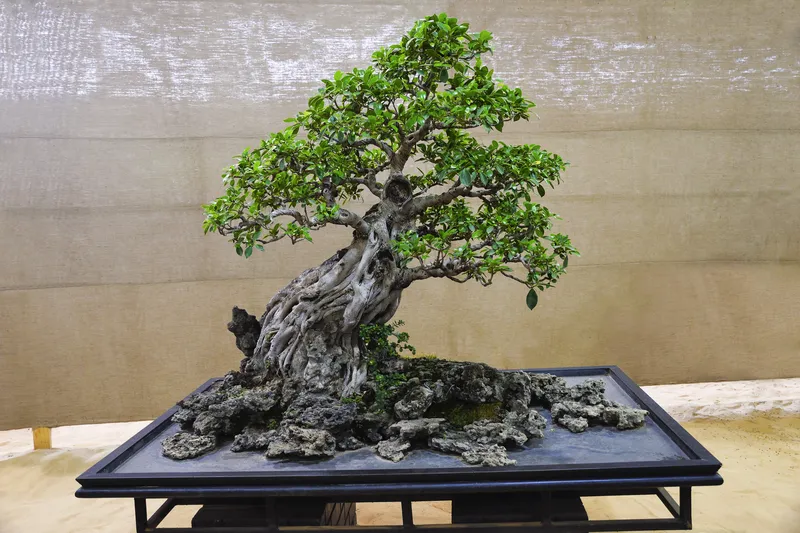
Ficus Retusa Tree Displayed During a Bonsai Exhibition
Let the plant grow freely for two years if you want a thick trunk for your Ficus bonsai. Afterward, the plant should be healthy enough to endure the major cuts needed to shorten the plant and encourage the trunk to thicken.
Wiring
The Ficus responds well to wiring. Feel free to use the medium to thick wire sizing, but check the plant every week to ensure the wire isn’t damaging. Young branches are very flexible. If you use wire to change or move branches, be cautious. Fast growth can create unsightly damage very quickly. (Especially in warm climates.)
Repotting
Every other year, during the spring, repot your Ficus. It responds very well to root pruning, making it a great choice for beginner bonsai enthusiasts. Bonsai Ficus trees may need re-potting twice a year in the tropics.
Root Pruning
Many bonsai hobbyists don’t trim Ficus roots often enough and eventually may use a saw to eliminate the mass (mess) created.
When necessary, the roots of most types of Ficus tolerate this radical power saw pruning and proceed to fill the pot again.
Propagation
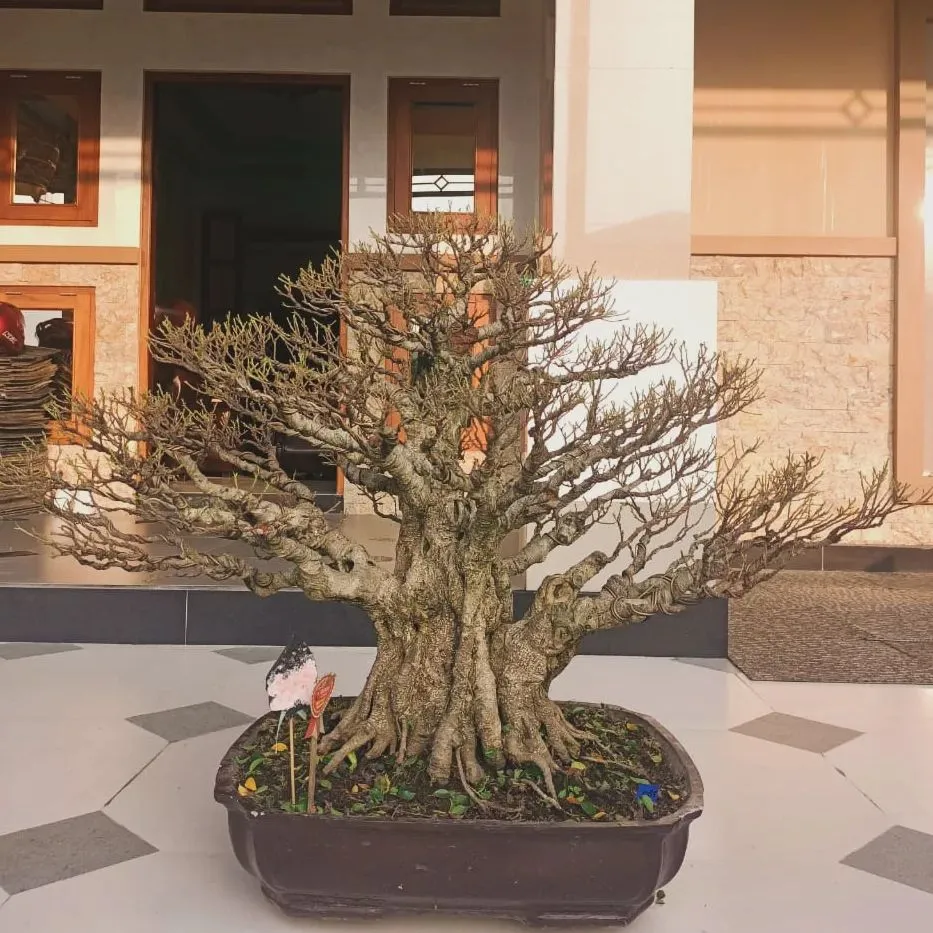


Ficus have high success rates with cuttings for propagation. For best results, cut and plant during mid-summer when it is at its highest growth rates. This will encourage the mother plant to heal quickly and give time for the cutting to grow strong roots and establish itself.
Pests & Diseases
All Ficus species are very hardy and resilient against pests and disease, another thing beginner bonsai hobbyists don’t have to worry too much about.
Something to be aware of, especially in the winter, is that constant dry air can cause the Ficus to drop its leaves. Mist the plant occasionally to deter this issue. If weakened due to environmental issues, spider mites may become a problem (they often seek out weakened plants).
Types Of Ficus Bonsai



Ficus Benjamina “Weeping Fig”

A young Ficus benjamina
This evergreen tree has slender leaves that are green when young and turn darker with age. The tree’s bark is grey. A great thing about the weeping fig is that aerial roots often develop (usually in humid environments).
Care
When pruning, the wounds become sticky with a latex-type of material which is toxic. Make sure to clean your hands after pruning the Ficus benjamina.
Many growers complain of the difficulty of caring for the Ficus benjamina. It is picky and requires consistency. It doesn’t do well when frequently moved. It will drop its leaves when not happy but will grow them back so don’t worry too much!
Water the Ficus benjamina once a week during the growing season, allowing the dirt to dry out (but not completely). It is good to maintain a regiment when caring for this bonsai.
Origin
The Ficus benjamina is originally from India and should be maintained in temperatures above 50 degrees Fahrenheit.
Common Bonsai Styling
Bonsai Styles: informal upright, cascade, twin trunk, and clumping.
Ficus Microcarpa “Indian Laurel”
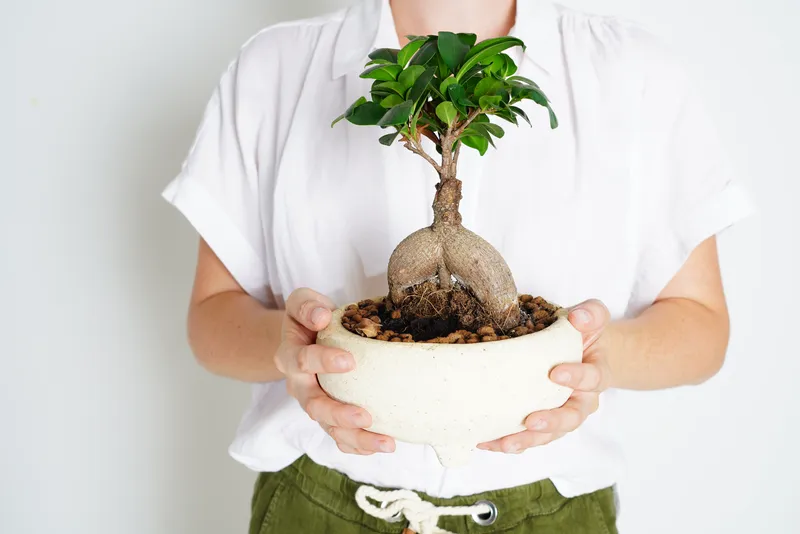
A young Ficus microcarpa
The Ficus microcarpa has often been confused and misnamed, the Ficus retusa (bonsai enthusiasts still misappropriate this name to the microcarpa).
This is an evergreen tree. It has a distinct crown and branches that display aerial roots from their lower sections. Their leaves are similar to the Ficus benjamina but darker still. The bark is grey and rough.
Pruning this ficus produces a toxic latex-type of solution. Make sure to clean your hands after pruning these trees.
Bonsai Styles: informal upright, cascade, twin trunk, and clumping.
Pictures Of Bonsai Ficus Around The World
One thing that makes them a little different from other figs is, that they do not like to have all of their leaves removed at once. Doing so can cause branches to die.
F. rubiginosa by Dorothy Koreshoff
Another Aussie favorite is the native Port Jackson fig – F. rubiginosa. Dorothy Koreshoff styled this bonsai Ficus from a 1949 cutting. This semi-cascade style is unique for a fig, but it in this case, it works. (Photo by Roger Hnatiuk at the November 2006 Australian Plants as Bonsai Exhibition held at the Australian National Botanic Gardens.)
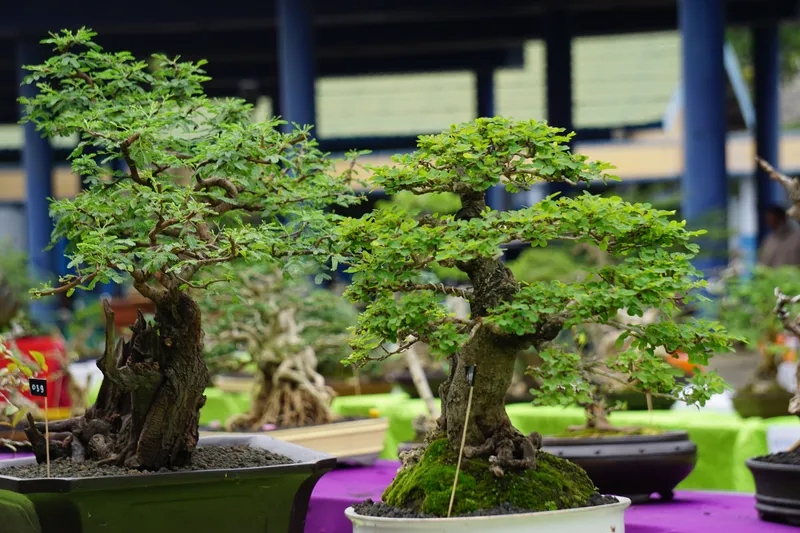
Bonsai from Indonesia – artist
Sometimes I receive photos from other people without sources. If you see your bonsai on any page of this site or recognize someone’s, please let me know.
F. neriifolia is especially popular because of its naturally small leaves. It is most often designed as a canopy-shaped bonsai. This grouping is a beautifully unique interpretation. The bark on this bonsai Ficus tree can vary in color from light brown to a reddish color. When reddish, the color can be slightly emphasized for exhibit with a very light coating of cooking oil.
The ‘Green Island’ is another exciting fig for bonsai. The leaves are naturally glossy and the figs are like small berries. Shown here at two years and then again, only three years later.
Bonsai retusa “Tiger Bark” So named because of the thin, almost white, stripes on the bark. The bark is very textured. Created by artist Norberto Rodriguez Arroyo of Puerto Rico.
Favorable Characteristics
Others find attractive features also advantageous to those creating miniature versions of this tropical tree. There are many reasons Ficus makes good bonsai.
- Spreading Roots – Mature fig trees have roots that ‘hug’ the ground, often spreading long distances from the main trunk.
Figs manage to thrive in a variety of unique conditions and easily adapt to bonsai pots and slabs. Shallow containers encourage the roots to spread as they can not go deep. As the roots spread, the trunk also spreads. The Japanese word for this feature is nebari.
- Interesting, Heavy Trunks – Most Ficus species evolve huge trunks in nature. Some are straight, some curved, others fluted. Some species have light-colored smooth bark, others are textured, and some are more colorful. One that has especially beautiful bark with white striations is the Ficus Golden Gate.
- Fast Growth – In their native habitats, these trees grow quickly. Sidewalks, fences, and walls have been destroyed.
Deserted homes have been swallowed up by their rampant growth. Ancient temples have been found completely covered by the invasive roots. On the good side of this fast-growth feature, you can develop quality Ficus bonsai trees in two or three years.
- Small Leaves – Not all fig trees have small leaves. Some are twelve inches or more across. Although leaf reduction is possible through defoliation, it is an ongoing project. Many Ficus bonsai trees have small leaves and most make excellent bonsai choices.
Why not try some of the best small leaf figs? Ficus benjamina variations, Ficus microphylla and Ficus nerifolia are just a few.
- Directional Pruning – A close look at a Ficus branch will show how the leaves are simple and alternating in their growth pattern. Because of their rapid growth, this branch structure is ideal for directional pruning.
- Flowers? – Yes, figs do have flowers. They are strangely located within fig. The figs are fertilized by certain wasps.
Curious about all this? There is a greatly detailed description on the Backyard Nature site.
- Fruit – (Technically not fruit in the true botanical sense.) Small and often colorful, figs grow on short stems, without stems, and in clusters depending upon the species.
Some figs grow directly off the trunk and branches. (Similar to jaboticaba, Myciaria cauliflora.) Fig colors vary from species to species.
F. benghalensis – commonly called the banyan tree – has cherry red figs when ripe. Unfortunately, this tree also has very large leaves, which makes it difficult for bonsai.
F. altissima, which resembles the banyan in every other way, has bright yellow fruit.
The “fruit” on tropical figs are not considered desirable for human consumption but are very popular with birds and monkeys.
Other figs have brown or reddish brown fruit, still, others are vibrant orange. In Ficus bonsai trees, the fruit is always to scale. On small trees, they may look like cherries or apples, while on larger plants, they resemble berries.
- Aerial roots – Some Ficus bonsai trees drop aerial roots from lateral branches just as they do in nature.
Also known as ‘prop’ roots or buttress roots, they often give extra support to the massive spreading “arms” of the banyan tree.
Some species grow aerial roots primarily off the trunk, still, others have none.
Occasionally, aerial roots keep the tree alive when the original trunk dies.
In the Calcutta Botanical Garden in India, one huge fig tree occupies over three acres. The number of the aerial root is beyond 3,000. Aerial roots on bonsai are valued because they help these trees resemble old banyans.
Personal Story – Ficus Philippinensis Bonsai
Just about the time I thought I was ready to move, I discovered a neglected, overgrown Ficus Philippinensis bonsai-to-be way in the back of my nursery. When I decided to downsize and move from Miami, it was quite a job to dispose of my bonsai collection and years of books, magazines, pots, tools, and more.
Somehow, I had forgotten about this plant. The roots of this Ficus had grown out of the bonsai pot, over the concrete block, and into the ground.
When I discovered it, I didn’t have the energy to do what it needed. I decided the next person who asked about it, could have it!
Victor Mills came for a visit and made the mistake of asking about the lonesome tree. Victor was the winner. First, he eyed the tree to be sure he really wanted it. He could see it was going to be quite a project just to free it from its self-imposed lock-up. We got out the loppers and saws.
Then, the question was – would it fit in his car?
Since Victor hadn’t decided how severe he would be with the styling, he left as much branching as he could. About a month later, I was pleased to receive this photo.
Although I had no doubt it would live, I was surprised at how quickly it responded to its new home. As time passed, I continued receiving status photos of this Ficus Philippinensis bonsai. (The same one I was about to leave to the tropical elements.)
What follows is an article meant for anyone who may feel overwhelmed.
Thank you, Victor, for the status and honest assessment of this Ficus bonsai.
Are You Guilty? Ficus Philippinensis Bonsai Follow Up
Guest Blurb by Victor Mills
Sometimes, when looking through others’ bonsai collections, I feel guilty for neglecting work on some of my trees.
If the pride you have for your collection has been smacked by life’s requirements and you’ve had those feelings too, this is for you, hoping to encourage you.
I’m a realtor in Miami with a large brokerage firm. With the market the way it is, I don’t have much extra time to do some of the things I know I should be doing when it comes to my trees. If your job has you doing overtime or experiencing anything similar in your life, there’s good news.
You can stop the guilt trip right now.
Don’t get me wrong, I love that tree, and I’d love to have it in tip-top shape, but it’s not. Frankly, I just haven’t had the time. We all make choices and time for what’s important, and that’s exactly what I’ve been doing. Sometimes work or family should have a higher priority.
Now the upside. It’s full of bright red berries (figs). It has the most berries I’ve seen in any previous year. (This red fruit is especially showy on Ficus Philippinensis.)
Sometimes we work trees so frequently that we don’t give them enough time to fully recuperate after work is done, or we don’t allow it to go into full bloom as it would in naturally. Neither is very good for it.
I know I can put the tree back into shape once I have some time. I can do the root work and repot it. I can clean the pot when I do. I can shape it and get a little more circulation going through it.
I can clean up the trunk and branches of this Ficus Philipinensis bonsai, select the aerial roots I want to keep, and get those weeds out of there.
I can address proportions and anything else I discover it needs when I’m doing those things.
You can too. Instead of feeling guilt, I suggest hanging in there, holding on to what attracted you to the art form.
Remember, how we work on a tree needs to have as much balance as the foliage and roots or feeding and watering. Too much or too little can have a negative impact.
Know your trees, your growing zone, and what your trees can or can’t tolerate. No need to be discouraged or feel guilt. Keep your priorities right, and remember that your tree may enjoy or even benefit from the time off.
After this check out our other articles on:
Frequently Asked Questions
How Often Should I Water My Ficus Bonsai Tree?
The watering frequency for Ficus bonsai trees may differ depending on factors such as pot size, tree size, and environment. As a general rule, you should water your Ficus bonsai tree when the top layer of soil feels dry to the touch. However, make sure not to overwater as Ficus trees can develop root rot.
How Much Sunlight Does My Ficus Bonsai Tree Need?
Ficus bonsai trees require bright, indirect light for at least 6 hours per day. They should not be placed in direct sunlight, which can cause leaf scorch.
How Do I Prune My Ficus Bonsai Tree?
Pruning is an important aspect of Ficus bonsai care, allowing you to control the tree’s size and shape. Use sharp, clean pruning shears to remove dead or damaged leaves, branches, or roots. You should also pinch back new growth regularly to encourage the tree’s growth pattern.
How Can I Prevent Pests And Diseases In My Ficus Bonsai Tree?
Ficus bonsai trees are vulnerable to various pests and diseases, including spider mites, mealybugs, and root rot. To prevent infestations, regularly check your tree for signs of pests and treat them immediately. Moreover, ensure that you maintain a consistent watering and fertilizing schedule and avoid overwatering, which can lead to root rot.






